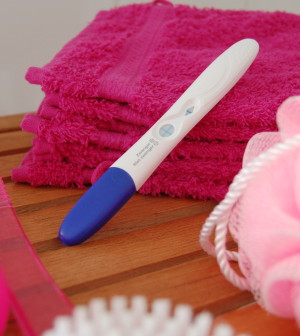- Skip Storing This Everyday Product in the Fridge Door
- Green Tea + B3 Pairing May Boost Brain Health
- Navigating Your Midlife Crisis: Embracing New Possibilities
- City Raccoons Showing Signs of Domestication
- Mapping the Exposome: Science Broadens Focus to Environmental Disease Triggers
- One Week Less on Social Media Linked to Better Mental Health
- Your Brain Changes in Stages as You Age, Study Finds
- Some Suicide Victims Show No Typical Warning Signs, Study Finds
- ByHeart Formula Faces Lawsuits After Babies Sickened With Botulism
- Switch to Vegan Diet Could Cut Your Greenhouse Gas Emissions in Half
More Evidence C-Sections Riskier for Moms


Women who deliver their first baby by cesarean section are more likely to need blood transfusions and be admitted to intensive care units than women who opt for a vaginal delivery, U.S. health officials reported Wednesday.
In addition, after that first C-section, nine out of 10 women will have their next infant delivered the same way, said report author Sally Curtin, a statistician at the U.S. Centers for Disease Control and Prevention’s National Center for Health Statistics.
“Having that first cesarean changes everything,” she said. “It changes the picture of whether you are even going to attempt labor next time.”
There are more health risks for mothers for repeat cesarean than vaginal deliveries, Curtin said. These risks include the need for transfusions, a ruptured uterus, the need to be admitted to an intensive care unit and an increased likelihood of requiring a hysterectomy, she added.
Curtin noted that cesarean deliveries still account for only 15 percent of all births. Most mothers, 85 percent, do not have a cesarean the first time they give birth, she said.
“It would be more fruitful to try to reduce the rate of primary cesareans, because if that woman has that first cesarean, the chances are nine out of 10 she’ll have a second,” she said.
Dr. Mark DeFrancesco, president of the American College of Obstetricians and Gynecologists, said, “Today’s report on maternal complications underscores the importance of efforts to avoid primary cesarean deliveries.”
Although cesarean sections can be lifesaving procedures, they are overused in the United States, he said. “In recent years, roughly one in three deliveries was performed with a cesarean,” DeFrancesco said.
Dr. Catherine Herway, assistant director of maternal-fetal medicine at Staten Island University Hospital in New York City, said many doctors opt for a second cesarean delivery to avoid the chances of being sued if something happens to the baby.
“To offer a vaginal delivery, you have to be in the hospital and be prepared for complications,” she said. “Repeat cesareans are so much easier and quicker. I have seen the number of people who are offering vaginal deliveries after a cesarean has really dropped off,” she said.
Herway said the way to avoid repeat cesareans is not to have the first one. “Women should educate themselves,” she said. And doctors shouldn’t be in a rush to do one unless there is a real medical reason for it, she said.
Other key findings in the report include:
- Rates of complications were higher for cesarean than vaginal deliveries: Transfusion and intensive care unit admissions rates were highest for first-time cesarean deliveries (525 and 383 per 100,000 live births); rates of ruptured uterus and unplanned hysterectomy were highest for repeat cesarean deliveries (89 and 143 per 100,000 live births).
- Higher rates of complications for cesarean compared with vaginal deliveries were found for nearly all age groups and for women from all racial and ethnic groups.
- Women who had vaginal deliveries had lower rates for all complications compared with those who had cesarean deliveries.
- Women who had a cesarean delivery but who had a vaginal birth for a second baby had lower rates for most complications. But those who failed labor had more complications than women who scheduled repeat cesarean deliveries. This was especially true for ruptured uterus, which was about seven times higher (495 per 100,000 live births compared with 66 per 100,000 live births).
More information
Visit the American Congress of Obstetricians and Gynecologists for more on C-sections.
Source: HealthDay
Copyright © 2025 HealthDay. All rights reserved.










